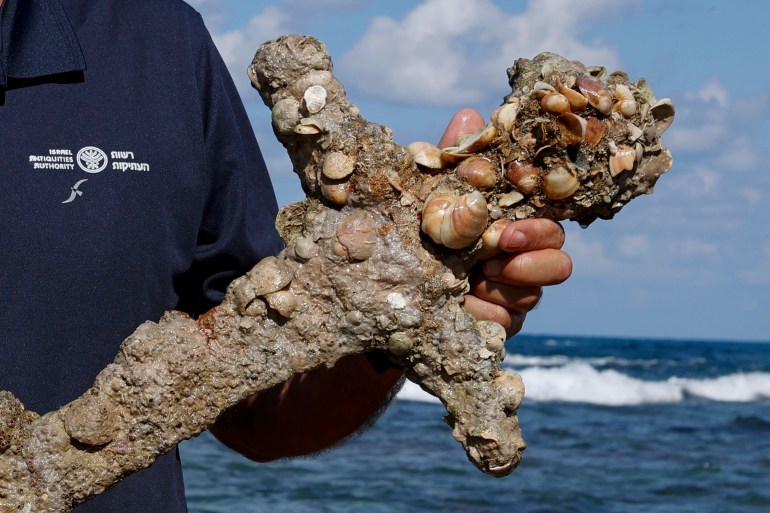A sword that is about 900 years old has been discovered by a divers, and experts believe it was lost in a beach battle during the Crusades.
In a report published by the American newspaper "New York Times" (nytimes), writer Eduardo Medina says that the sword, which was found at the bottom of the Mediterranean Sea off the coast of occupied Palestine, is made of iron, with the exception of the handle, which was made in that period of wood or other materials.
The sword was spotted by Israeli diver Shlomi Katzin on the sandy ground in the depths of the Mediterranean Sea.
Archaeologists believe that the sword, which weighs about two kilograms and is about 4 feet long, was used 900 years ago during the Crusades.
"Katzen was surprised and happy," said Jacob Sharvit, director of the marine archeology unit at the Israel Antiquities Authority.
Katzin confirmed that he was keen to take a picture with the weapon covered with algae, crustaceans and seashells, before handing it over to the Antiquities Authority.
Sharvit: The sword is a "priceless" piece and will be placed in an Israeli museum after it is cleaned and studied (French)
rare pieces
Katzin previously discovered many other artifacts during diving operations, as he found stone anchors and pottery fragments dating back hundreds of years, but the sword, which Charvet described as "extremely rare", is the most valuable piece.
All the pieces were found within an area of no more than 1,000 square feet, after a storm caused the sand to dislodge.
"It is normal to find the remains of some swords, but this sword was found under water in very good condition. It is the first time we have found a beautiful sword like this," Charvet said.
The waters off the Carmel coast are characterized by stable temperatures throughout the year, which helped keep the sword in good condition throughout this period.
Charvet confirmed that the iron oxidation process made the shells and other marine organisms - such as gum - stick to the sword and keep it in good condition.
The stability of the water temperature off the Carmel coast throughout the year helped keep the sword in good condition throughout this period (French)
Battles near the beaches
Jonathan Phillips, professor of the history of the Crusades at Royal Holloway, University of London, says that Muslims defeated the Western Crusaders in Damascus during the Second Crusade.
During the Third Crusade, French King Philip Augustus, King Richard I (known as Richard the Lionheart) and Holy Roman Emperor Frederick I (also known as Frederick Barbarossa) launched a new battle to conquer Jerusalem.
Dr. John Coates, Professor of Medieval History at Whitman College in Washington state, asserts that the Muslim leader Saladin, who was ruling Egypt, Syria and Iraq, conquered Jerusalem in 1187.
In that period, Pope Gregory VIII tried to provoke the feelings of Western Christians to recover Jerusalem from the Muslims, but the Muslim army was able to preserve the city.
Dr. Phillips stresses that making the sword was expensive at the time, adding that it made sense to find it at sea, because many battles took place near the shores.
Sharvit said that the sword will be placed in an Israeli museum after cleaning and studying it, stressing that it is a "priceless" piece.

